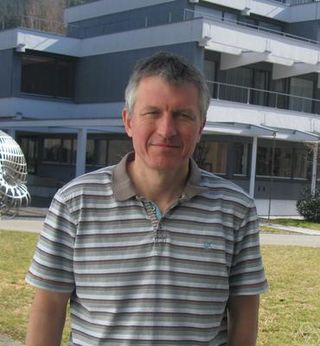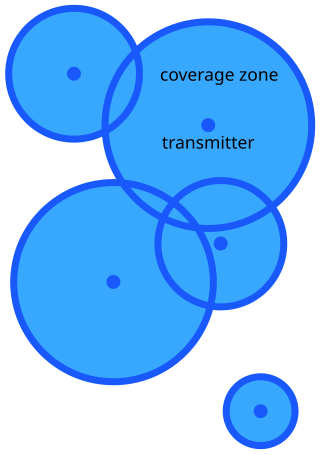Related Research Articles

Maurice Stevenson Bartlett FRS was an English statistician who made particular contributions to the analysis of data with spatial and temporal patterns. He is also known for his work in the theory of statistical inference and in multivariate analysis.
In statistics and probability theory, a point process or point field is a collection of mathematical points randomly located on a mathematical space such as the real line or Euclidean space. Point processes can be used for spatial data analysis, which is of interest in such diverse disciplines as forestry, plant ecology, epidemiology, geography, seismology, materials science, astronomy, telecommunications, computational neuroscience, economics and others.
Nils Lid Hjort is a Norwegian statistician, who has been a professor of mathematical statistics at the University of Oslo since 1991. Hjort's research themes are varied, with particularly noteworthy contributions in the fields of Bayesian probability, density estimation and nonparametric regression, model selection, confidence distributions, and change detection. He has also worked with spatial statistics, statistics of remote sensing, pattern recognition, etc.

Bradley Efron is an American statistician. Efron has been president of the American Statistical Association (2004) and of the Institute of Mathematical Statistics (1987–1988). He is a past editor of the Journal of the American Statistical Association, and he is the founding editor of the Annals of Applied Statistics. Efron is also the recipient of many awards.
Spatial statistics is a field of applied statistics dealing with spatial data. It involves stochastic processes, sampling, smoothing and interpolation, regional and lattice (gridded) data, point patterns, as well as image analysis and stereology.

Peter Gavin Hall was an Australian researcher in probability theory and mathematical statistics. The American Statistical Association described him as one of the most influential and prolific theoretical statisticians in the history of the field. The School of Mathematics and Statistics Building at The University of Melbourne was renamed the Peter Hall building in his honour on 9 December 2016.

Christopher C. Holmes is a British statistician. He has held the position of Professor of Biostatistics in Genomics in the Nuffield Department of Clinical Medicine and the Department of Statistics at the University of Oxford since September 2014, a post that carries with it a Fellowship of St Anne's College, Oxford. Previously he was titular Professor of Biostatistics and a Fellow of Lincoln College. After working in industry he completed his doctorate in Bayesian statistics at Imperial College, London, supervised by Adrian Smith.

Jayanta Kumar Ghosh was an Indian statistician, an emeritus professor at Indian Statistical Institute and a professor of statistics at Purdue University.

In mathematics, stochastic geometry is the study of random spatial patterns. At the heart of the subject lies the study of random point patterns. This leads to the theory of spatial point processes, hence notions of Palm conditioning, which extend to the more abstract setting of random measures.

Richard John Samworth is the Professor of Statistical Science and the Director of the Statistical Laboratory, University of Cambridge, and a Teaching Fellow of St John's College, Cambridge. He was educated at St John's College, Cambridge. His main research interests are in nonparametric and high-dimensional statistics. Particular topics include shape-constrained density estimation and other nonparametric function estimation problems, nonparametric classification, clustering and regression, the bootstrap and high-dimensional variable selection problems.
A boundary problem in analysis is a phenomenon in which geographical patterns are differentiated by the shape and arrangement of boundaries that are drawn for administrative or measurement purposes. The boundary problem occurs because of the loss of neighbors in analyses that depend on the values of the neighbors. While geographic phenomena are measured and analyzed within a specific unit, identical spatial data can appear either dispersed or clustered depending on the boundary placed around the data. In analysis with point data, dispersion is evaluated as dependent of the boundary. In analysis with areal data, statistics should be interpreted based upon the boundary.
Jan Hemelrijk was a Dutch mathematician, Professor of Statistics at the University of Amsterdam, and authority in the field of stochastic processes.
In probability and statistics, a spherical contact distribution function, first contact distribution function, or empty space function is a mathematical function that is defined in relation to mathematical objects known as point processes, which are types of stochastic processes often used as mathematical models of physical phenomena representable as randomly positioned points in time, space or both. More specifically, a spherical contact distribution function is defined as probability distribution of the radius of a sphere when it first encounters or makes contact with a point in a point process. This function can be contrasted with the nearest neighbour function, which is defined in relation to some point in the point process as being the probability distribution of the distance from that point to its nearest neighbouring point in the same point process.
In probability and statistics, a nearest neighbor function, nearest neighbor distance distribution, nearest-neighbor distribution function or nearest neighbor distribution is a mathematical function that is defined in relation to mathematical objects known as point processes, which are often used as mathematical models of physical phenomena representable as randomly positioned points in time, space or both. More specifically, nearest neighbor functions are defined with respect to some point in the point process as being the probability distribution of the distance from this point to its nearest neighboring point in the same point process, hence they are used to describe the probability of another point existing within some distance of a point. A nearest neighbor function can be contrasted with a spherical contact distribution function, which is not defined in reference to some initial point but rather as the probability distribution of the radius of a sphere when it first encounters or makes contact with a point of a point process.
Alan Enoch Gelfand is an American statistician, and is currently the James B. Duke Professor of Statistics and Decision Sciences at Duke University. Gelfand’s research includes substantial contributions to the fields of Bayesian statistics, spatial statistics and hierarchical modeling.
Dorota Maria Dabrowska is a Polish statistician known for applying nonparametric statistics and semiparametric models to counting processes and survival analysis. Dabrowska's estimator, from her paper "Kaplan–Meier estimate on the plane" is a widely used tool for bivariate survival under random censoring.

Jesper Møller is a Danish mathematician.
Eva Bjørn Vedel Jensen is a Danish mathematician and statistician known for her work in spatial statistics, stereology, stochastic geometry, and medical imaging. She is a professor emeritus in the Department of Mathematical Sciences at Aarhus University.

Jorge Mateu is a Spanish mathematician, author, and academic. He is a professor of Statistics within the Department of Mathematics at University Jaume I of Castellon and Director of the Unit Eurocop for Data Science in criminal activities in the same department.
References
- ↑ Hazelton, Martin L.; Turner, R. (2021). "A Festschrift for Adrian Baddeley". Australian & New Zealand Journal of Statistics. 63 (1): 1–5. doi:10.1111/anzs.12322. ISSN 1369-1473. S2CID 238895437.
- ↑ A. Baddeley, E. Rubak and R.Turner, "Spatial Point Patterns: Methodology and Applications with R", Chapman and Hall/CRC Press 2015.
- 1 2 A. Baddeley and E.B. Vedel Jensen, Stereology for Statisticians, Chapman and Hall/CRC Press 2005.
- ↑ A.J. Baddeley, H.J.G. Gundersen, and L.M. Cruz-Orive. Estimation of surface area from vertical sections. Journal of Microscopy, 142:259-276, 1986
- ↑ A.J. Baddeley and R.D. Gill, Kaplan-Meier estimators of interpoint distance distributions for spatial point processes. Annals of Statistics 25: 263-292, 1997.
- ↑ M.N.M. van Lieshout and A.J. Baddeley, A nonparametric measure of spatial interaction in point patterns. Statistica Neerlandica 50:344-361, 1996.
- ↑ A. Baddeley, J. Møller and R. Waagepetersen, Non- and semiparametric estimation of interaction in inhomogeneous point patterns, Statistica Neerlandica 54: 329-350, 2000.
- ↑ A.J. Baddeley and J. Møller, Nearest-neighbour Markov point processes and random sets. International Statistical Review 57:89-121, 1989.
- ↑ A.J. Baddeley and M.N.M. van Lieshout, Area-interaction point processes. Annals of the Institute of Statistical Mathematics 47:601-619, 1995.
- ↑ A. Baddeley and T.R. Turner, Practical maximum pseudolikelihood for spatial point patterns. Australian and New Zealand Journal of Statistics 42:283-322, 2000
- ↑ A. Baddeley, Time-invariance estimating equations. Bernoulli 6: 783-808, 2000.
- ↑ A. Baddeley, J.-F. Coeurjolly, E. Rubak and R. Waagepetersen, Logistic regression for spatial Gibbs point processes. Biometrika 101:377-392, 2014.
- ↑ A. Baddeley and R. Turner. Spatstat: an R package for analyzing spatial point patterns. Journal of Statistical Software 12(6):1-42, 2005. www.jstatsoft.org
- ↑ "2016 Honorary Award Recipients". secretariat.curtin.edu.au. 14 February 2017. Retrieved 30 March 2024.